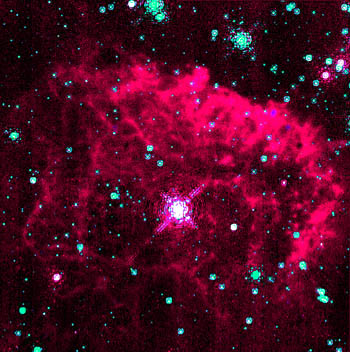
Click for a high resolution view.
The Pistol Star (STScI)
 Click for a high resolution view. The Pistol Star (STScI) |
From: PRESS RELEASE NO.: STScI-PR97-33
The image, taken by a University of California, Los Angeles (UCLA)-led team with the recently installed Near-Infrared Camera and Multi-Object Spectrometer (NICMOS) aboard Hubble, also reveals a bright nebula, created by extremely massive stellar eruptions. The nebula is so big (four light-years) that it would nearly span the distance from the Sun to Alpha Centauri, the nearest star to Earth's solar system.
The astronomers estimate that when the titanic star was formed one to three million years ago, it may have weighed up to 200 times the mass of the Sun before shedding much of its mass in violent eruptions.
"This star may have been more massive than any other star, and now it is without question still among the most massive -- even at the low end of our estimates," says Don F. Figer of UCLA. "Its formation and life stages will provide important tests for new theories about star birth and evolution."
The Pistol Star was first noted in the early 1990s, but its relationship to the nebula was not realized until 1995, when Figer proposed in his Ph.D. thesis that the "past eruptive stages of the star" might have created the nebula. The Hubble spectrometer results confirm this conclusion.
The astronomers believe that the Pistol nebula was created by eruptions in the outer layers of the star which ejected up to 10 solar masses of material in giant outbursts about 4,000 and 6,000 years ago. The star will continue to lose more material, eventually revealing its bare hot core, sizzling at 100,000 degrees.
Burning at such a dramatic rate, the Pistol Star is destined for certain death in a brilliant supernova in 1-3 million years. "Massive stars are burning their candles at both ends; they are so luminous that they consume their fuel at an outrageous rate, burning out quickly and often creating dramatic events, such as exploding as supernovae," said Mark Morris, a UCLA professor of astronomy and co-investigator. "As these stars evolve, they can eject substantial portions of their atmospheres -- in the case of the Pistol Star, producing the nebula and an extreme stellar wind (outflow of charged particles) that is 10 billion times stronger than our Sun's." The Pistol Star would be visible to the naked eye as a fourth magnitude star in the sky (which is quite impressive given its distance of 25,000 light-years) if it were not for interstellar dust clouds of tiny particles between the Earth and the center of the Milky Way that absorb the star's light. The most powerful telescopes cannot see the Pistol Star in visible wavelengths. However, ten percent of the infrared light leaving the Pistol Star reaches Earth, putting it within reach of infrared telescopes, which have seen rapid technological advances in recent years -- spurred by projects such as NICMOS. The Pistol Star was so massive when it was born that it brings into question current thinking about how stars are formed, say the UCLA astronomers. In the current view, stars form within large dust clouds which contract under their own gravity, eventually forming hot clumps that ignite the hydrogen fusion process.
The star may radiate enough energy to halt the inward fall of material, thus limiting its maximum mass. The initial mass of the Pistol Star may have exceeded this theoretical upper limit. "It is perhaps no accident that this extreme-mass star is found near the center of the Galaxy," says Morris. "Current evidence leads us to believe that the star formation process there may favor stars much more massive than our modest Sun."
Over the coming year, the team will be using the new near-infrared spectrometer that Ian S. McLean's team is building at UCLA for the giant 10-meter Keck II telescope in Hawaii. The new instrument will be used to measure the velocities of the expanding gas shells.
In addition to Figer, Morris, and McLean, the team also includes Caltech physicist Gene Serabyn and Columbia University astronomer R. Michael Rich.